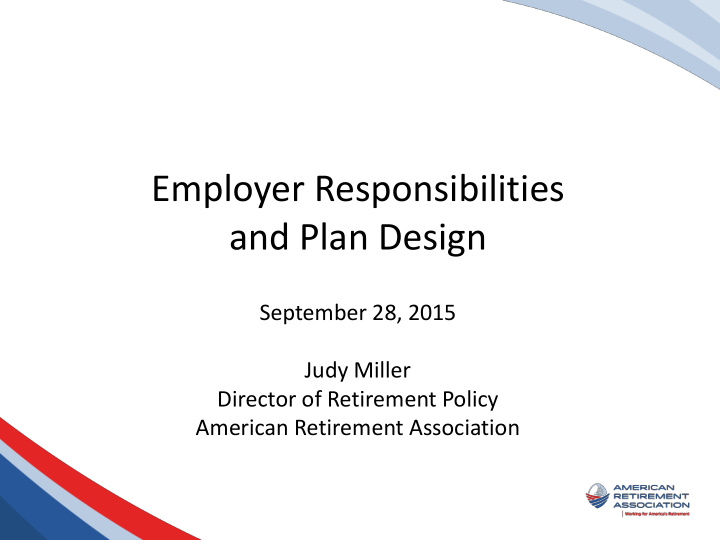



Employer Responsibilities and Plan Design September 28, 2015 Judy Miller Director of Retirement Policy American Retirement Association
Employer Responsibility to Be Limited • 100012(a)(3) “With simplicity, ease of administration for participating employers, and portability of benefits .” • 100034 (b) “ An employer shall not bear responsibility for the administration, investment, or investment performance of the program. An employer shall not be liable with regard to investment returns, program design, and benefits paid to program participants.”
But can’t be avoided • Employer responsibilities: – Distribute enrollment materials – Initial opt-out (or “active choice”)/change of withholding elections – Open enrollment/ re-enrollment windows – Withholding (and forwarding) employee contributions • Auto-escalation – Withdrawal forms – provide or advise employees/ former employees who to contact
Automatic Enrollment • Increases % saving for retirement* – Vanguard found participation rates for new hires making less than $30,000 were 87% with auto-enrollment and only 22% for voluntary enrollment. – For $30,000-$49,999 the rates were 90% and 41% respectively. • Opt-outs increased from 11% to 19% for workers earning less than $30,000 per year when initial rate increased from 3% to 6%. • Without automatic escalation, a substantial portion of workers will not increase their contribution rate. *Clark, Utkus , and Young, 2015. “Automatic enrollment: The power of the default” Vanguard Research.
Simple Design • Automatically enroll new employees at 6% of pay – Opportunity to opt-out or contribute a different % or dollar amount • For those contributing less than 6%, auto- enroll at 6% in even-numbered years • No auto-escalation Note: 6% is an example, not a recommendation
Simple Design • Pros: – Minimizes opportunity for employer error • Most contributing at the same rate, and once correct rate is in the system, low maintenance – Easy to remind employers and employees of re-enrollment period. – Employees moving from one covered employer to another will have no disruption in contribution rate • Concerns: – Initial contribution rate becomes more critical than if there was auto-escalation
Auto-escalation Design 1 • Automatically enroll new employees at 3% of pay – Opportunity to opt-out or contribute __% or $___ • Default auto-escalation (with opt-out) – Contribution rate increases 1% per year on anniversary of employment • If a new employee contributed to the plan through a previous employer, auto-enroll at the greater of their last contribution rate or 3%. • For those contributing less than 3%, periodically auto-enroll at 3%
Auto-escalation Design 1 • Pros: – Employees can start contributing at a modest rate, but most will end up with a more substantial rate of savings • Concerns: – More time consuming for the employer – More to track means more opportunities for error • Easy to forget to increase contributions on anniversary date, or increase for someone who opted out • Easy to forget to check on past covered employment/contribution rates • Variety of contribution rates so harder to spot errors
Auto-escalation Design 2 • Automatically enroll new employees at 3% of pay – Opportunity to opt-out or contribute __% • Default auto-escalation (with opt-out) – Contribution rate increases 1% per year on anniversary of employment January 1 if employed on the previous July 1. • If a new employee contributed to the plan through a previous employer, auto-enroll at the greater of their last contribution rate or 3%. • For those contributing less than 3%, periodically auto-enroll at 3%
Auto-escalation Design 2 • Pros: – Employees can start contributing at a modest rate, but most will end up with a more substantial rate of savings • Concerns: – More time consuming for the employer, but increases limited to once per year. – More to track means more opportunities for error • Easy to May forget to increase contributions on anniversary date, or increase for someone who opted out. • Easy to forget to check on past covered employment/contribution rates • Variety of contribution rates so harder to spot errors – Employees who switch jobs likely to have reduced contribution rate
Auto-escalation Design 3 • Initial auto-escalation for program as a whole – For example, program opens in 2017. Auto- enroll at 3% with 1% increases to begin January 1, 2019. – January 1, 2019, rate goes to 4% for new and existing auto-enrollees, – January 1, 2020 rate goes to 5% for new and existing auto-enrollees, – and so on until the ultimate rate is reached for the plan as a whole.
Auto-escalation Design 3 • Pros: – Less initial contribution withholding shock for the thousands of employees initially enrolled in the program – Upcoming increases can be easily communicated to employers and employees – Employees moving from one employer to another will continue on the upward contribution path • Cons: – Too high an initial rate after phase-in could affect take-up.
Balancing Act? • Contribution goals: – What is your rate of contribution target? – After the plan has been in effect for x years, would it be reasonable/effective to enroll newly cover employees at that rate? – How will you get there? • Fixed auto-enroll/ active enroll rate? • With auto-escalation? – Individual level – Plan level
Balancing Act? • Employer’s involvement: – The more frequently an employer has to review contribution rates, increase contribution rates, or re-enroll opt-out employees, the more opportunity there is to miss something or someone. • Simpler is better: – Less opportunity for error means more satisfaction for employers and employees.
Recommend
More recommend